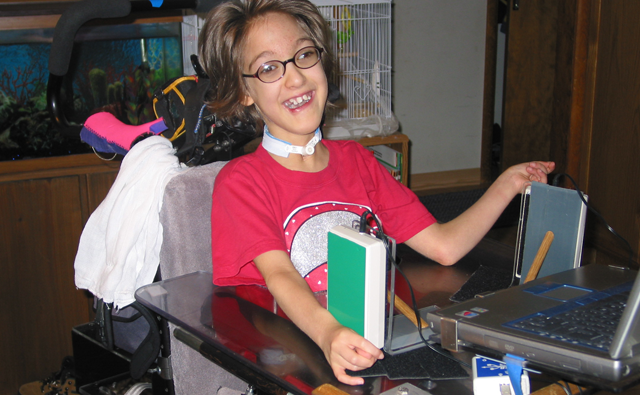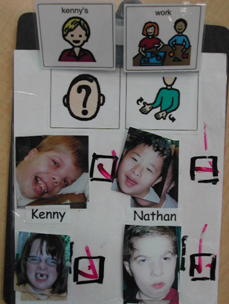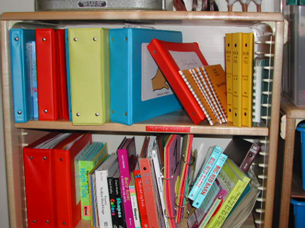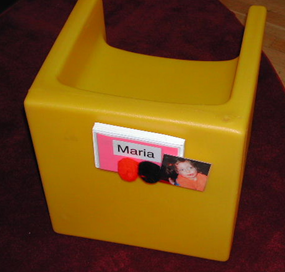Emergent Literacy
Young children who have normal vision and hearing are regularly exposed to print and words through daily activities. They listen to stories, rhymes, and songs and frequently observe others reading and writing. These children are poised and ready to develop literacy skills. They rapidly develop language and social skills and quickly absorb information about how the world works (e.g. objects exist and have permanence and things have names, characteristics, and purposes). By observing and imitating the people around them and by participating in everyday activities, they easily acquire the foundations of literacy. They attach meaning to letters, recognize their own names, find familiar words in picture books, and play simple word games. They enjoy learning about the sounds letters make, how they fit together to make words and may begin to use familiar words to form sentences. They delight in hearing favorite stories and creating their own.
In addition to 'can-do,' reading is much more fun - for you and your child - if she also develops a 'want to' attitude. (Trelease, 2006)
Because children with combined vision and hearing loss have absent or decreased access to everyday activities, they typically lack opportunities for incidental learning. As a result, they have a much more difficult time participating in the wide and varied literacy activities experienced by children with normal vision and hearing. Instead, children with vision and hearing loss depend on their parents, teachers, and caregivers to find new ways to offer interesting and meaningful literacy experiences. This begins when the adults in their lives believe that every child can learn to "read" and "write," and hold the expectation that they will, even though for some children it may look different than what we usually think of as traditional reading and writing.

Children who are deaf-blind need books and writing materials that are adapted to their unique vision, hearing, and physical needs. They also require learning activities that connect objects, pictures, letters, and words to what they already know and understand. Special attention should be paid to identifying a child's current level of knowledge about his or her life and experiences and to providing learning experiences that expand these concepts. This requires in-depth knowledge of how each child takes in information and communicates with others, as well as predictable and consistent interactions with the child that help him or her process new information.
Activities that promote literacy learning are directly linked to activities that promote communication, interactions with others, and concept development. Avoid teaching literacy skills in isolation and instead find creative ways to teach literacy in the context of what makes sense to a particular child.
Related Skills
Literacy skills should not be taught in isolation because they relate to numerous developmental and academic standards often being addressed by a child's educational team. Awareness of interrelated skills assists teams in IEP development and planning holistic instruction.
Attention and Response
Attention/response to informational cues; attention/response to literacy partner; attention/response to stories and word play activities (spoken or signed); increased duration of active engagement with stories or music (spoken, recorded or signed)
Interaction and Communication
Anticipation; joint attention; turn-taking; ability to access literacy partner; increased duration of active engagement with stories, music and/or literacy partner; use of pre-linguistic forms of communication (touch, object, gestures and/or cures); response to informational cues; partial/full participation in instructional activities
Sensory
Use of residual hearing and residual vision to gather information; localization to presented sounds; auditory discrimination; visual fixation; eye gaze; use of tactile skills for sensory input
Tactile/Motor
Exploration of items using touch; imitation of simple motor tasks; opening/closing a book; holding a book; turning pages of a book; tactile discrimination; eye-hand coordination
Cognitive
Object permanence; spatial and positional concepts such as front/back, top/bottom; beginning/middle/end; sequence of events; recall of verbal and non-verbal events; one-to-one correspondence; put together/take apart; use of emergent symbolic forms (e.g. pictures and/or line drawings)
Examples
Snow Cone Activity (Power Point)
This is an example of a tactile book that was created as part of a learning unit with a winter theme. The lesson involved making Snow Cones and the book represented each step in the activity. The book was read to the class before the activity to pre-teach the lesson. It was used again while making the snow cones and after the activity as a review. Then students had access to the book in the library corner to further reinforce the activity and provide a way to remember it and share it.
PowerPoint Book Templates from Deaf-Blind Model Classroom Project (UNC Center for Literacy and Disability Studies)
Templates for creating ABC books and personal books for students with significant disabilities, including deaf-blindness. The templates have high contrast backgrounds, some have finger spellings (finger spelling photos are free from Pics4Learning.com) and all are setup to include an auditory click and some movement when students turn pages.
Expand Awareness of Books, Print, and Writing



Emergent Literacy IEP Goals
List of actual IEP goals developed for students in UNC's Deaf-Blind Model Classroom research project.
Video Clips
Literacy and Deaf-Blindness, Kathee Scoggin
Introduction to a variety of techniques for creating/adapting books and literacy activities to make them interesting and relevant to students with deaf-blindness.
Experience Books
Overview, videos, and FAQs from Washington Sensory Disabilities Services on experience books and how to use them to encourage literacy for children with deaf-blindness and/or multiple disabilities.
Smart Boards
Webcast describing ways to use Smart Boards to enhance literacy learning as well as several online programs/software (many free) designed for this purpose.
Teaching Braille Reading and Writing
Webcast overview, not specific to deaf-blindness, that provides a good introduction to the subject of Braille.
Colby's Daily Journal: A School-Home Effort to Promote Communication Development
An article and video that describes the components of a child's daily journal and how the daily preparation and review of the journal supports his communication development.
Articles
Top Ten Tools from the Trenches
Great tips directly from teachers who have been working in model classrooms for students with deaf-blindness.
Using Story Boxes with Older Children
A good example of the use of age appropriate materials by describing a Harry Potter story box.
Promoting Literacy through Emergent Writing
Descriptions and photos of adapted and non-conventional writing materials using common objects.
Writing Considerations
Descriptions and photos of a variety of adapted writing tools and strategies for providing computer access to children with sensory and/or physical challenges.
Colby's Daily Journal: A School-Home Effort to Promote Communication Development
An article and video that describes the components of a child's daily journal and how the daily preparation and review of the journal supports his communication development.
Concept Development
A one-page introduction to how concept development is affected by combined vision and hearing loss.
Object Books
This is a brief summary about object books and how to create them.
Additional Resources
Center for Early Literacy (CELL)
Overview of the CELL approach to early literacy learning in home and classroom settings (Literacy-rich environments, Child interests, Everyday literacy activities and Responsive teaching).
Experience Books: FAQs - Washington Sensory Disabilities Services
Practical answers to common questions about experience books.
Story Boxes: A Hands-on Literacy Experience
Includes purpose, descriptions, how-to and suggested titles.
My Own Bookshelf
Computer program for creating virtual books and individualized libraries. A 30-day free trial offer is available.
Accessible Books and E-Texts
An extensive collection originally compiled by Dinell Stuckey from Kansas (Brianna's mom). It is now maintained by MATN (Maryland Assistive Tech Network). Samuel's Online Bookshelf at the top of the page is a great PDF accessible tool for choosing books to read. Definitely something here for everyone!
Model Classroom Resources
Includes information on shared reading, chart writing, alphabet activities, remnant books, partner assisted scanning, switch mounts, and downloadable templates for PowerPoint ABC books.
Louisiana Access Guide
Resources from the Louisiana Department of Education Access Guide for Students with Significant Disabilities.
Children's Bookstore
An online bookstore that is dedicated to offering the best in juvenile literature.
Module 8: Making and Choosing Good Books for Independent Book Use
This module provides tips for making books for independent student use, as well as some existing resources for good, age appropriate books.
